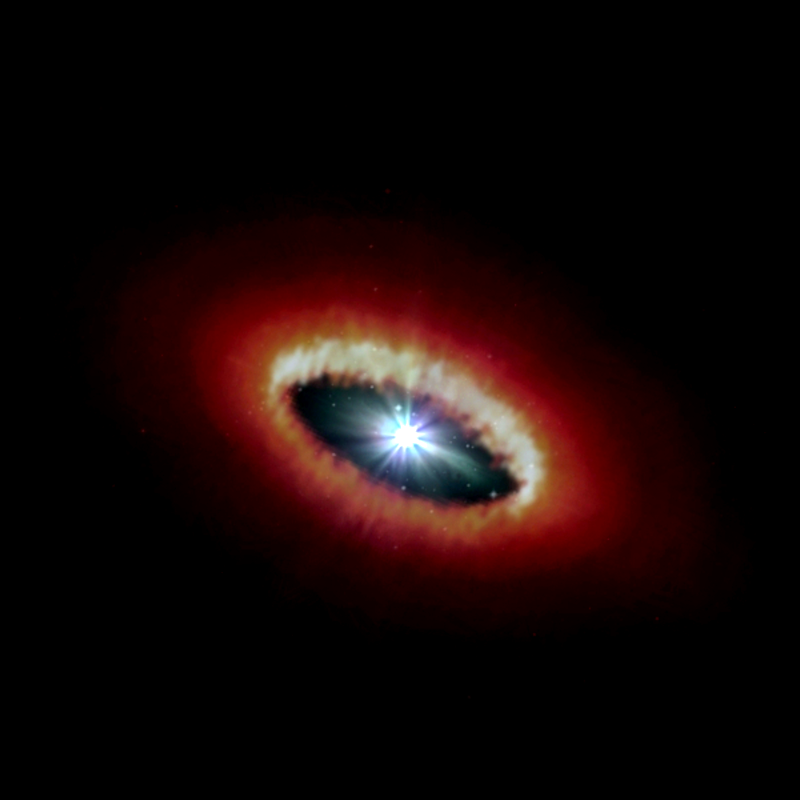

Being affected throughout their lifetime by a strong mass-loss due to radiative winds,fast rotation, and a high binarity rate, massive stars pose several challenges to the understanding of their observational properties and evolution.
The aim of our project is to improve our knowledge of these objects by coupling state-of-the-art two-dimensional simulations of stellar interiors including rotation, pulsations, and mass-loss, with radiative transfer models of their atmospheres and environment, in order to compare the resultant predictions with observations at the highest spectral and angular resolutions. This unique combination of fundamental modelling, radiative transfer, and confrontation with observations will enable us to improve the models of massive stars, as well as our understanding of the underlying physics. Finally, we will deliver to the community,improved grids of models of typical massive stellar interiors, atmospheres, and extended environments, as well as constraints on the stellar and circumstellar parameters of the closest O, B, and A stars.
Our project relies on the unique expertise in the development and exploitation of spectrointerferometric instruments in Nice, in particular MATISSE, the new mid-infrared instrument of the Very Large Telescope Interferometer (VLTI) array at ESO-Paranal, and SPICA, the upcoming visible beam-combiner for the Center for High Angular Resolution Astronomy (CHARA) array at Mount Wilson Observatory, as well as the successes of the ESTER code, developed in Toulouse, which models rapidly rotating early-type stars in 2D, and the TOP pulsation code, developed in Paris-Meudon, for carrying out seismic inferences.
MASSIF is a joint project of the Observatoire de la Côte d'Azur (member of the Université Côte d'Azur), the Université de Toulouse and the Observatoire de Paris-Meudon. It is funded by the Agence Nationale de la Recherche for the 2022-2025 period.

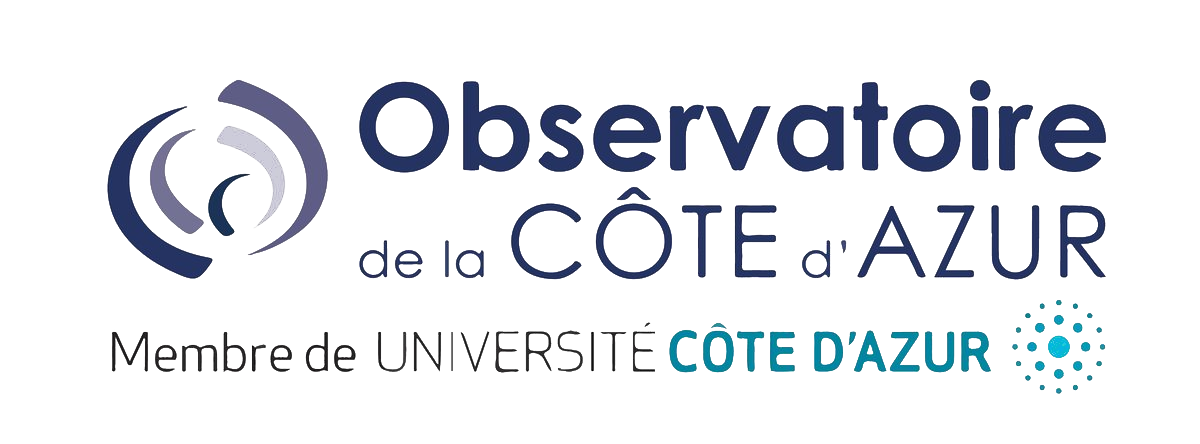
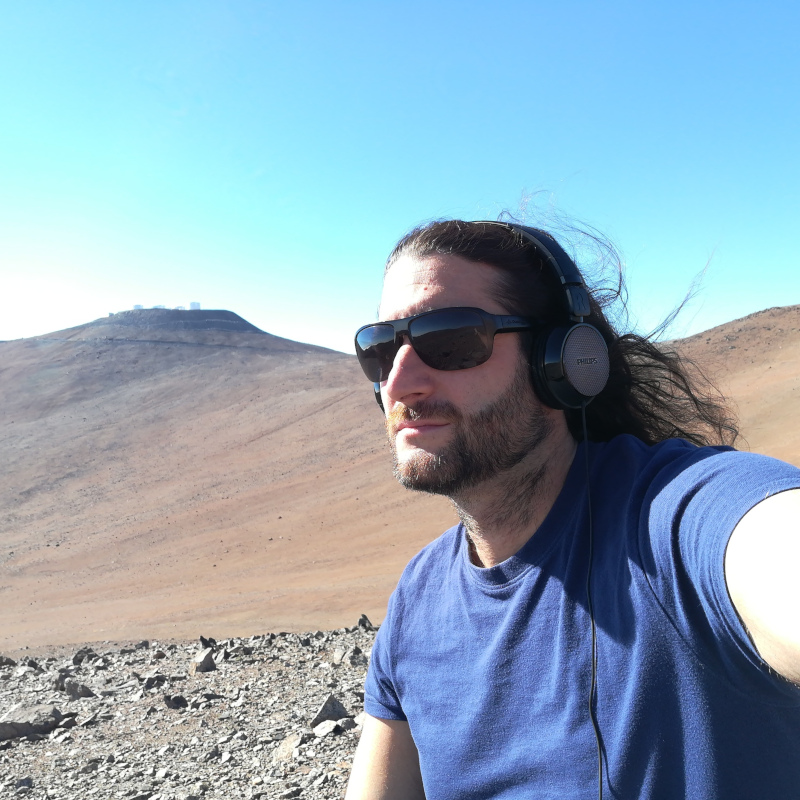
is a specialist of long-baseline interferometry and modelling of the environments of massive stars. After initial studies in astrophysics at the Nice University, he passed his PhD on radiative transfer and spectro-interferometric analysis of classical Be star decretion disks in 2007. A. Meilland is one of the main contributors to the long list of publications made with the first-generation instrument AMBER, especially on massive stars (including Be stars, supergiant B[e] stars, blue supergiants, and yellow hypergiants) and he also contributed significantly to other scientific breakthroughs in the fields of young stellar objects, active galactic nuclei, and novae. A. Meilland to the 2nd generation instrumental developments at CHARA and VLTI. He contributed to the development and test of CHARA/FRIEND (Martinod et al. 2018), a prototype to test new technologies (detector, spatial filtering) now being implemented in CHARA/SPICA. He was the main developers of MATISSE Near-Real-Time software, and worked for ESO during the MATISSE commissioning to implement observing procedures. A. Meilland supervised, with A. Domiciano de Souza, the PhD thesis of E. Saldanha (defended in 2020) on the multi-band multi-technique modelling of disks and winds around massive stars. He coordinates teaching efforts at the JMMC, the French centre for infrared and optical interferometry, and organised in 2021 the 10th VLTI school aimed at teaching interferometry to PhD students and postdocs from all over the world.

with Francisco Espinosa Lara, is the creator of the 2D ESTER code (Espinosa Lara & Rieutord 2013, Rieutord et al. 2016), with a large experience in fluid mechanics and the physics of stellar interiors and photospheres of rotating stars. He was the PI of the ANR project ESRR (2016-2020), where ESTER has been further developed, and used to interpret interferometric observations of Altair (Bouchaud et al. 2020, see Fig. 2). The code can now compute self-consistently the structure and the large-scale flows of early-type stars at any rotation rate below critical. The results of Gagnier et al. (2019a,b) on rapidly rotating massive stars have shown the major influence of mass-loss on the rotational evolution of these stars. Gagnier & Rieutord (2020a) have further shown the impact of the spin-down due to mass loss on the internal large-scale flows of massive stars. The subject is now ripe for a coupling between angular momentum extraction by a radiative wind and internal spin-down flows that may trigger, if a threshold is crossed, a chemically homogeneous evolution.
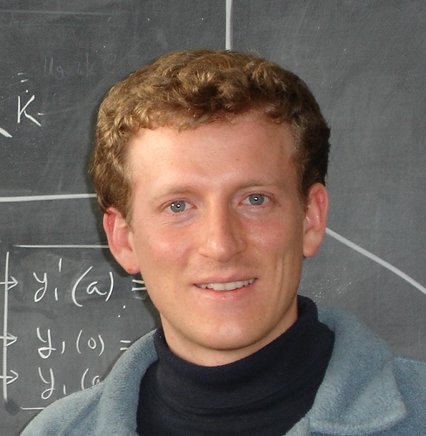
very experienced in asteroseismology and numerical simulations, for instance by developing the AIMS code for carrying out seismic inferences in a grid of stellar models, and InversionKit an interactive Java code for seismically probing 1D stellar profiles and determining global stellar properties via inverse techniques. He is the creator of the 2D TOP code (Reese et al. 2021) which computes the eigenmodes of rapidly rotating 2D-ESTER models. He has developed both an adiabatic and non-adiabatic version of TOP, and extended mode visibility calculations to rapidly rotating stars (Reese et al. 2013) for the purposes of mode identification (Zwintz et al. 2019; Bouchaud et al. 2020). Such a 2D-code is needed to study the pulsations of massive stars, as rotation cannot be ignored, many of them being fast rotators. For instance, as shown by Burssens et al. (2020), the TESS mission includes several massive stars in its photometric data (e.g. Balona & Ozuyar 2020, Pedersen et al. 2019) but the modelling of their pulsations has been left aside since 1D models cannot cope with their rotation rate. D. Reese and A. Domiciano de Souza supervised the PhD thesis of K. Bouchaud (defended in 2020)

has a large experience in the study of massive stars and stellar rotation, based on the combination of physical modelling (CHARRON code; Domiciano de Souza et al. 2002, 2018) and of high angular and high spectral observations, in particular from ESO-VLT(I) instruments. He has led the first detailed interferometric study of the photosphere of a Be star (Achernar), measuring its rotational flattening, gravity darkening, and the interface between photosphere and close environment (e.g. Domiciano de Souza et al. 2003, 2012, 2014). In the context of the ANR ESRR (PI: M.Rieutord; project finished in 2020) he supervised (with D. Reese) the PhD thesis or K.Bouchaud, which resulted in the most realistic 2D model (ESTER) of a fast rotator (Altair) constrained by interferometric and asterosismologic data. He also supervised the PhD thesis of three other students.
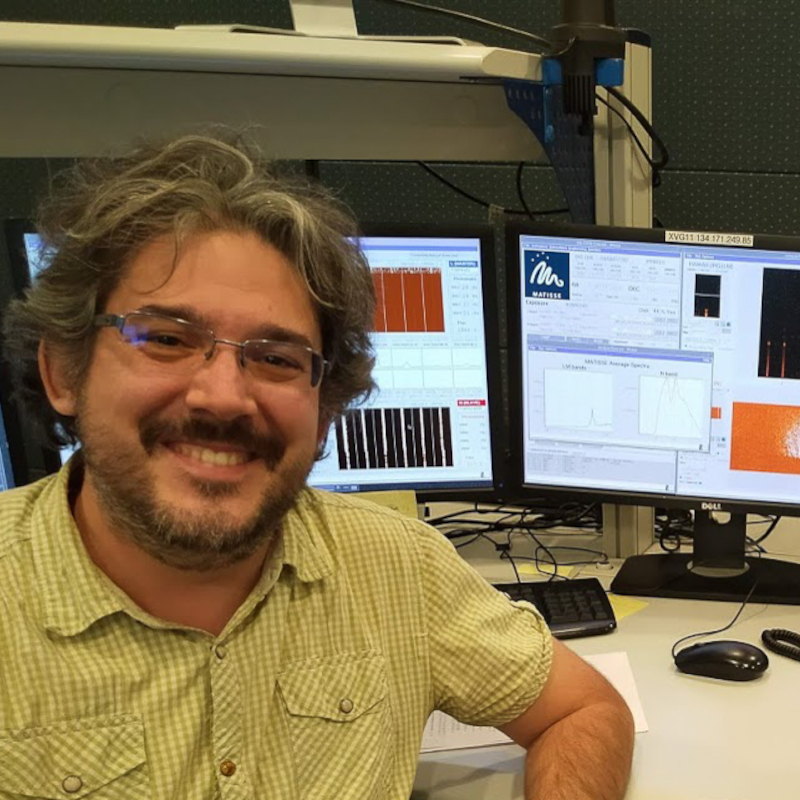
is a specialist of long-baseline optical interferometry with focus on instrumental development and data analysis but also on modelling massive stars. During in phD in Nice and post-doctoral fellowship in Bonn, he participated in the building, software development and astrophysical exploitation of the VLTI first generation instrument AMBER. He developed polychromatic model-fitting (fitomatic) and image reconstruction (self-cal module for MIRA) software allowing to fully exploit the AMBER capabilities and produce for instance the first high-angular-and-spectral images of a rotating disk around of massive supergiant B[e] star . Back in Nice as an associate Astronomer, he joined the MATISSE project, coordinating the development of the data reduction software, the MATISSE consortium programs on stellar physics and participating in the commissioning of the instrument. He now works in upgrading the VLTI within the GRAVITY+ project, developing a test-bench in Nice for the future adaptive optic systems for the 8m telescopes to enhance the sensibility of the array.

Margaux obtained her Master in Astrophysics from Paris Observatory in July 2022. During her Master, she carried out internships data analysis of gravitational waves, detected and simulated, and the standard siren method within the framework of the European collaborations Virgo and LISA in 2020 and 2021. For her last internship in 2022 she worked on the polarimetric optical data of the binary star at the AGB L2 stage Puppis obtained with the SPHERE/VLT instrument. In September 2022, she joined the MASSIF team as a phD student in Nice on "multi-band spectro-interferometric survey of massive stars with the new generation instruments at VLTI & CHARA" under the supervision of A. Domiciano de Souza and A. Meilland.

Joey Mombarg defended his PhD entitled ‘Asteroseismic modelling of intermediate-mass stars’ in February 2022 at KU Leuven, Belgium, in the group of Conny Aerts. His PhD research focussed on developing a forward modelling scheme to estimate stellar properties such as mass, age, and mixing efficiencies from gravity-mode pulsations in intermediate-mass stars. During his PhD he managed to secure a long-stay travel grant from the Flemish Research Foundation (FWO) to work with Michel Rieutord in Toulouse on coupling 2D rotation profiles from ESTER to the 1D stellar structure and evolution code MESA to compute the efficiency of rotational mixing in the radiative envelope of massive stars. J. Mombarg has now started his postdoctoral research position with Michel Rieutord to improve the current ESTER models, particularly focussing on mass-loss.

did his PhD under the supervision of João P. C. Marques, on the 2D modelling of the transport of angular momentum in stellar radiative zones, at the IAS in Orsay (FR). He defended in January 2021 and then moved to the Max Planck Institute in Göttingen (DE), to work in the group of Laurent Gizon. There, he worked on determining the requirements for stellar evolution models used in PLATO to achieve the best accuracy on the model-dependent determination of mass, radius and age. He also implemented in CESAM2k20, the stellar evolution code chosen to compute PLATO's first generation grid of models, a method based on entropy-calibration. Such modelling allows getting rid of a free parameter involved in models of convection, which was one of the largest sources of uncertainties in models. He starts his next postdoctoral position in February 2023 with D. Reese to work on the asteroseismology of massive rotating stars.
The MASSIF ANR project is dedicated to the study of massive stars using synergies between experts in the fields of numerical simulations of stellar interiors, asteroseismology, high-angular resolution observations and data analysis. This multi-technique approach and the collaboration between our groups in Nice, Toulouse and Paris began five years ago with the ESRR ANR project (2016-2020). Using our expertise in our respective fields of research, we demonstrated the power of combining state-of-the-art interferometric observations with asteroseismology and 2D stellar interior modelling in our work on the intermediate-mass star Altair published in Bouchaud et al. (2020).
from interferometric & asteroseismologic observations and 2D stellar interior modelling
Bouchaud et al. (2020)

Pulsations

Rotational Rate
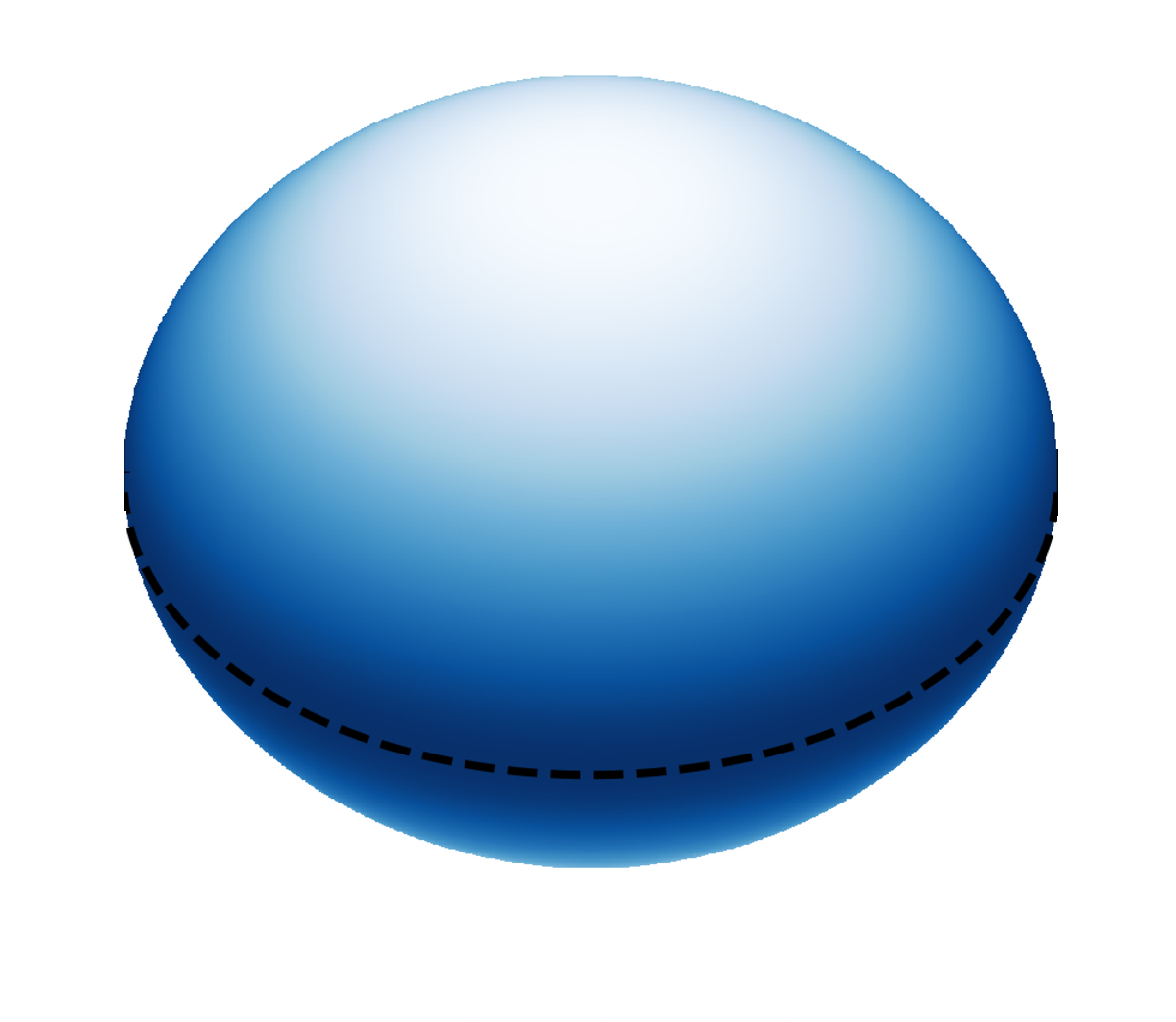
Surface Temperature
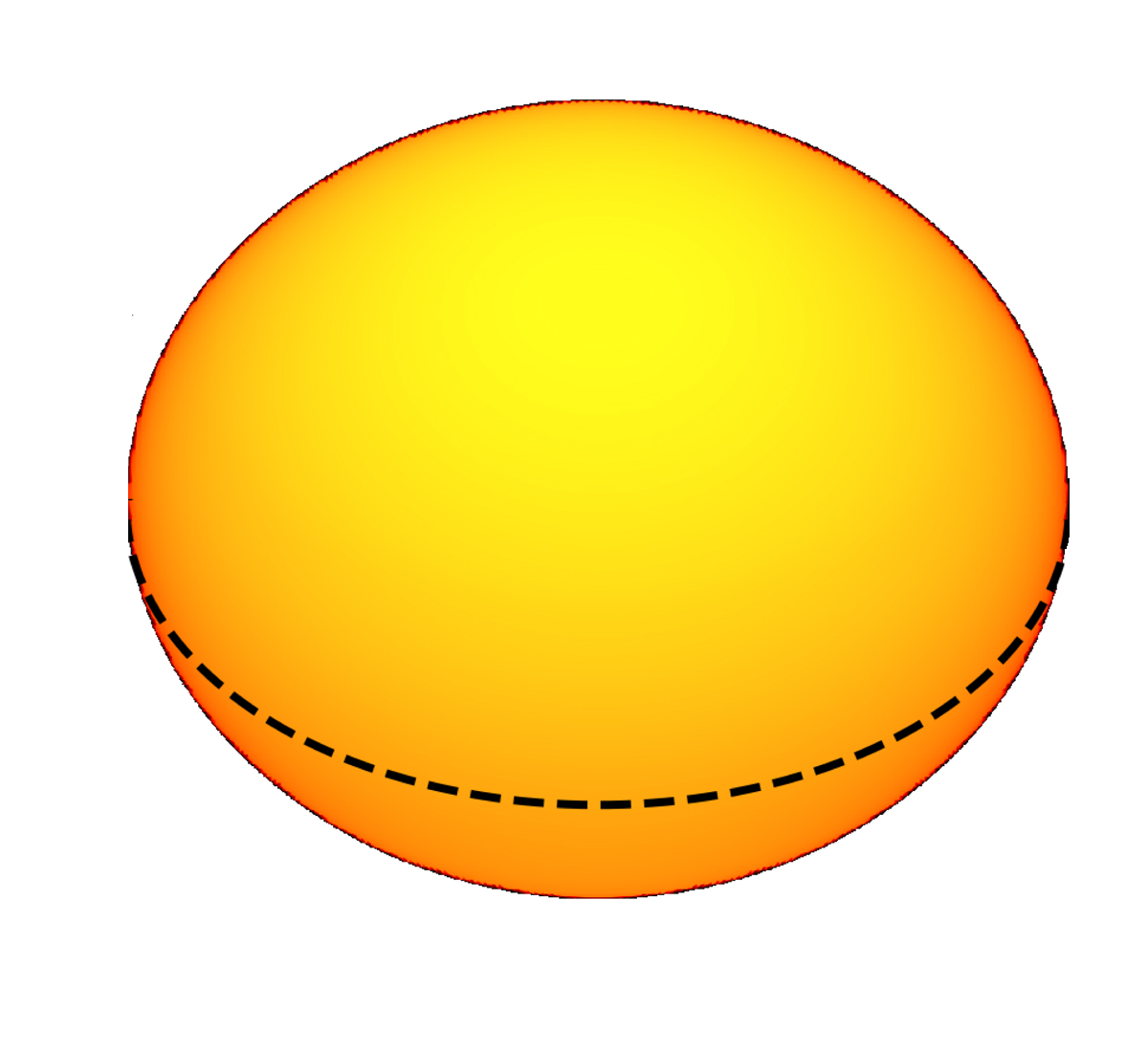
Effective Gravity
Building on this success, we now propose to apply the same methodology on a large sample of more massive stars. To reach this goal, we need to improve our modelling of stellar interiors including rotation, pulsations and the launching of a radiative wind. These tasks will be performed in the first two work-packages of this ANR project (WP1 & WP2). The third work-package (WP3) deals with modelling large amounts of interferometric data, with a focus on improving grids of radiative transfer models of CSE of massive star disks and winds, and on polychromatic modelfitting and image reconstruction techniques. The last work-package (WP4) focuses on surveys of massive stars observed at the highest possible resolution, which includes data already acquired from the first generation of instruments at the VLTI and CHARA and new visible and infrared observations of 200 stars. The Figure below summarises the organisation of our ANR MASSIF and the WPs are detailed in dedicated sections.

In Nice we have a privileged access to the two major optical/IR interferometric facilities in the world: VLTI (Southern hemisphere) and CHARA (Northern hemisphere). For almost two decades, we have been developing instruments for these facilities starting with AMBER (Petrov et al. 2007), the now decommissioned but still most prolific interferometric instrument ever built (22% of all refereed publications on optical interferometry by 2021) and VEGA (Mourard et al. 2009) a visible beam combiner of CHARA. Nice is now the PI institute of MATISSE (Lopez et al. 2018), the new mid-infrared VLTI instrument and SPICA (Mourard et al. 2018), the upcoming next generation visible instrument at CHARA, the two key instruments of our survey. Thanks to these instrumental developments and the expertise in analysing interferometric observations, especially of massive stars and their CSE, the team in Nice has been PI of many observing programs and now owns a wealth of interferometric data on more than 60 massive stars. Our sample is still growing as MATISSE is now producing a large amount of data on massive stars, and SPICA will observe more than one hundred of them during its three-year all-sky survey starting next year..
Thanks to our priviledged access to these instruments we aim at deriving accurate stellar parameters (mass, Teff, radius, rotational velocity, gravity darkening, etc.) and constrain the structure of the environment (mass-loss rate, density and temperature laws) of about 200 massive stars using visible-to-mid-infrared spectro-interferometric measurements. We will focus on close to main sequence stars with a mass ranging from 4 to 20 Mo, but also include a few more evolved objects, i.e. hot supergiants and B[e] stars in the same mass and temperature range, since the modelling of these objects will strongly benefit from the models and tools we aim at developping in our project.
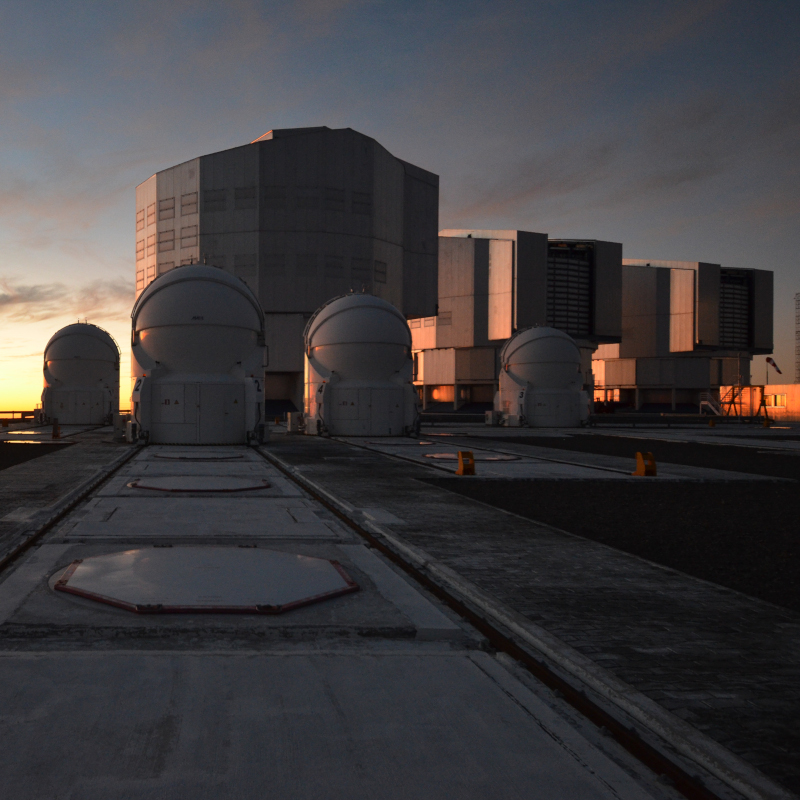
MATISSE is the new four-telescope mid-infrared (3-13 microns) combiner at VLTI. It was designed and built by a consortium of institutes led by the Observatoire de la Côte d’Azur in Nice and is available for the scientific community since April 2019. MATISSE offers a unique opportunity to constrain the physical properties of gaseous and dusty circumstellar environments (i.e., density,temperature, chemistry, and dynamic laws). In the case of hot massive stars, it will provide strong constraints on the parameters defining these physical properties, since they are the input quantities of models of radiative winds and decretion disks. Moreover, interpreting these multiband observations with physical models will help to significantly improve our understanding of the mechanisms responsible for the mass-ejection, and subsequent CSE formation and dissipation, and finally to characterise the effects of mass-loss on stellar evolution and on the chemical and energetic enrichment of the interstellar medium.
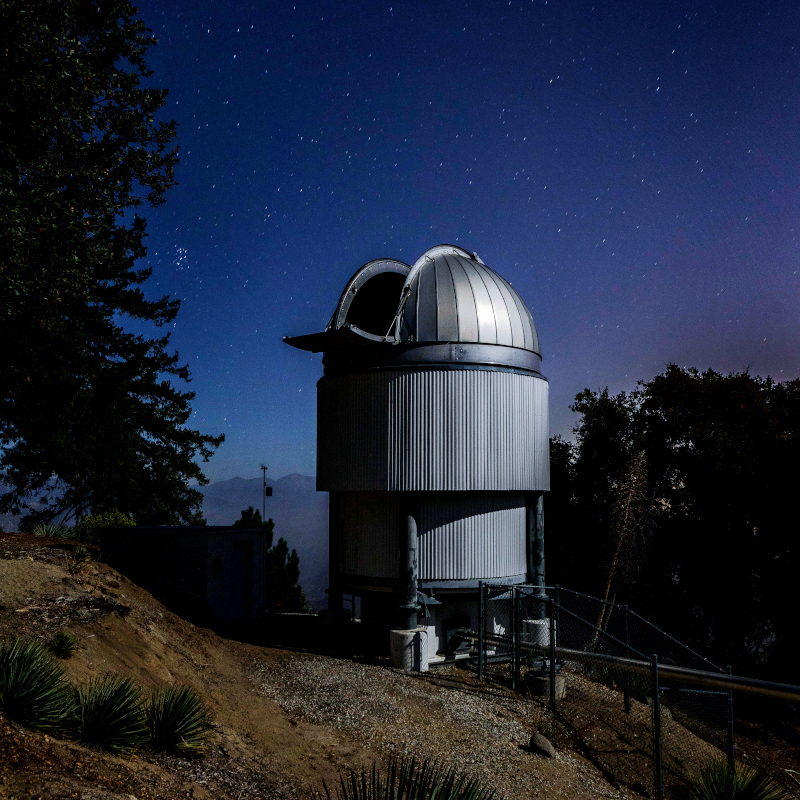
SPICA is the new visible beam-combiner developed in Nice that will be installed on the CHARA array in 2022. Unlike its predecessor VEGA, it will simultaneously combine the beams of up to six telescopes and will offer real imaging capabilities with a resolution down to 0.5 mas. Using a state-of-art photon-counting detector, spatial filtering with optical fibers, a dedicated fringe-tracker in the near-infrared, and the newly installed adaptive optics of the CHARA telescopes, observations with SPICA will be faster and more accurate than the previous generation of visible instruments and will offer a better sensitivity limit. SPICA will be a unique instrument to resolve the photospheres of stars, with a capability to measure accurate stellar diameters down to 0.2 mas and to image stellar surfaces down to 0.8 mas. One of the main challenges of the instrument is to measure a sample of 1000 stars (800 diameters + 200 images) in a three year period between 2022 and 2024. Moreover, thanks to its high spectral spectral modes it will also allow us to resolve atomic lines and perform spectro-interferometric analysis and imaging of stellar surfaces (in photospheric lines) and environment (in emission lines), putting additional strong constraints on the physics and dynamics of stars and their environments compared with broad band studies.

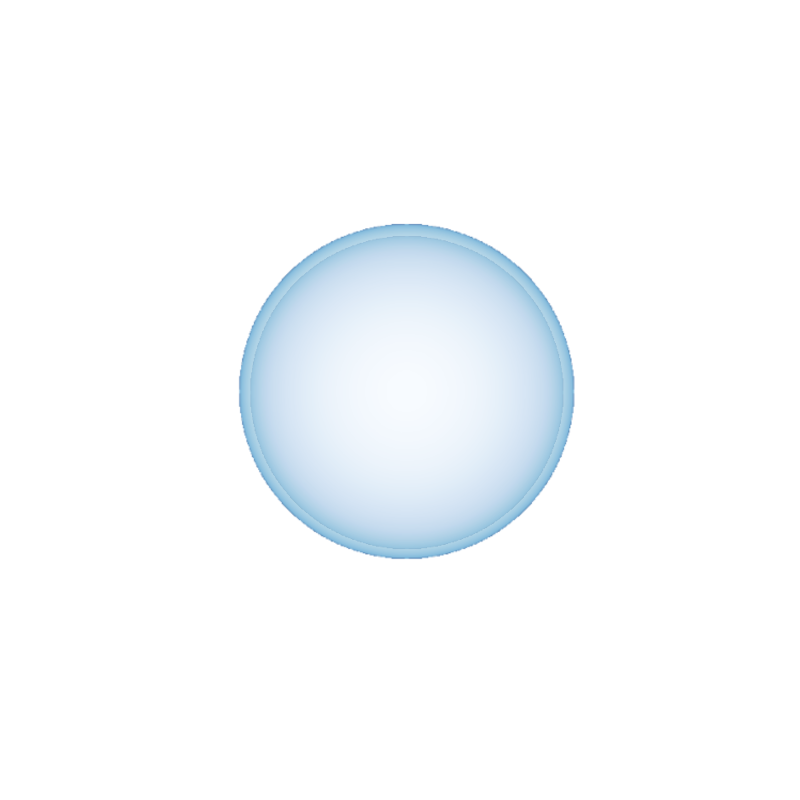

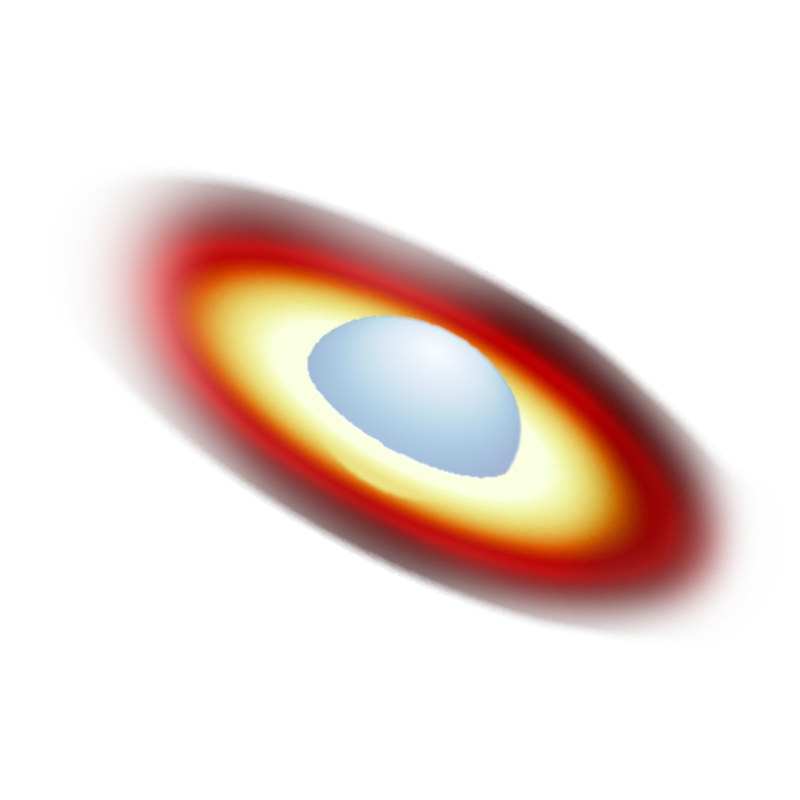
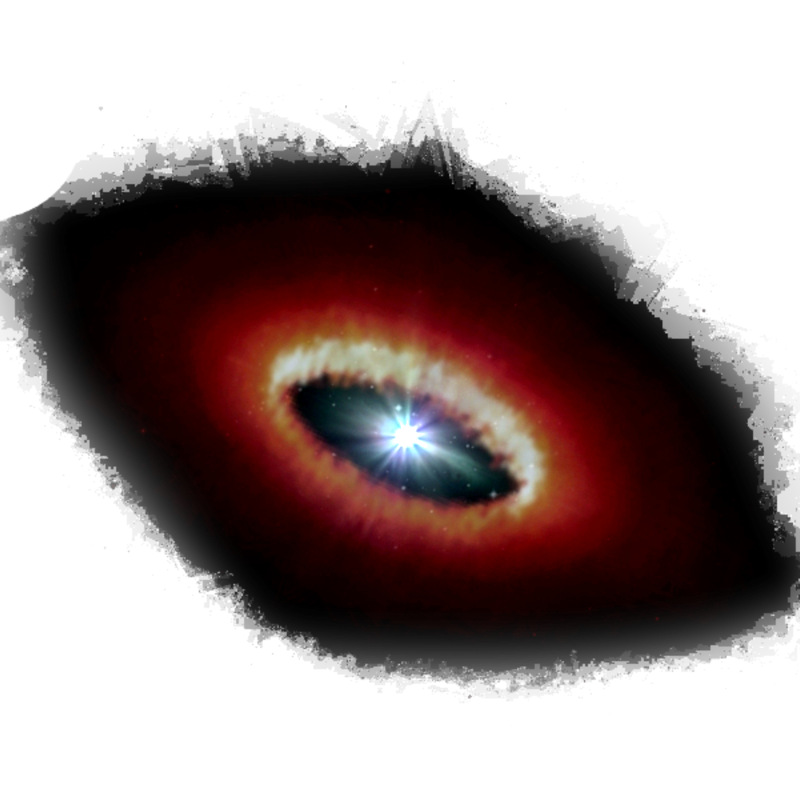
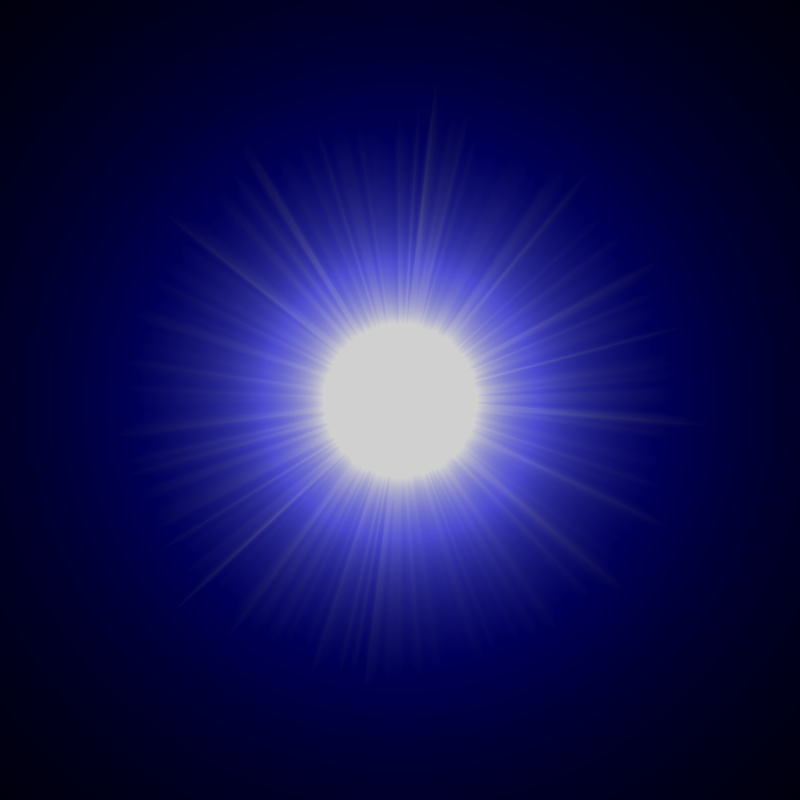
The MASSIF ANR project is dedicated to the study of massive stars using synergies between experts in the fields of numerical simulations of stellar interiors, asteroseismology, high-angular resolution observations and data analysis. This multi-technique approach and the collaboration between our groups in Nice, Toulouse and Paris began five years ago with the ESRR ANR project (2016-2020). Using our expertise in our respective fields of research, we demonstrated the power of combining state-of-the-art interferometric observations with asteroseismology and 2D stellar interior modelling in our work on the intermediate-mass star Altair published in Bouchaud et al. (2020).
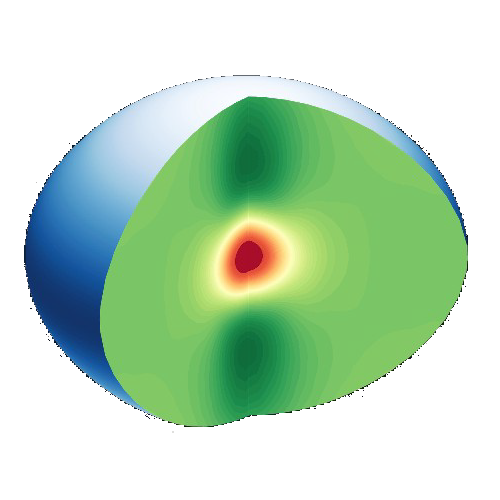
The ESTER code (Evolution STellaire en Rotation) aims at provinding a two-dimensional stellar evolution code, which fully takes into account the effects of rotation, at any rate and in a self-consistent way. The difficult, but important point is that rotating stars are spheroidal and are never in hydrostatic equilibrium. The ESTER code is, at the moment, computing the steady state of an isolated early-type star (mass larger than 2 solar masses). The only convective region computed as such is the core where isentropy is assumed. It provides the user with solutions of the partial differential equations, for the pressure, density, temperature, angular velocity and meridional velocity for the whole volume. The angular velocity (differential rotation) and meridional circulation are computed consistently with the structure as a result of the driving by the baroclinic torque.

Top (Two-dimensional Oscillation Program) is a code which computes the eigenmodes of rapidly rotating 2D-ESTER models. It fully takes into account the centrifugal deformation and has been set up to apply a multi-domain spectral approach, in accordance with the models from ESTER. Moreover, the TOP pulsation code is able to calculate both adiabatic and non-adiabatic pulsations. Such a 2D-code is needed to study the pulsations of massive stars, as rotation cannot be ignored, many of them being fast rotators. The determination of stellar pulsations is currently the only way we have to probe stellar interiors, and as such complements the constraints obtained through interferometry and spectroscopy. This then provides stringent constraints on the stellar interior models obtained with the ESTER code, and in particular on differential rotation and more generally on transport processes.
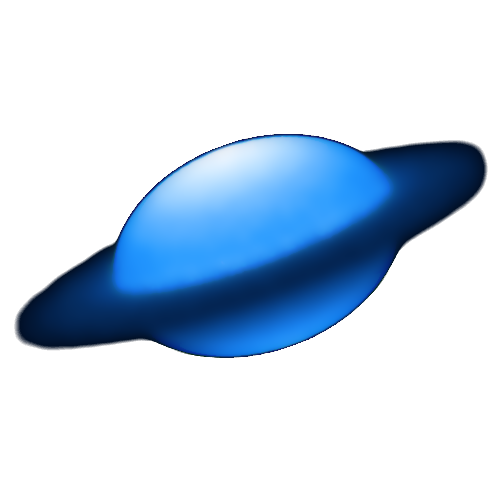
The HDUST code (Carciofi et al. 2017) is a 3D radiative transfer code based on the Monte Carlo method, dedicated to model (images, SED, and line profiles) of stars with gaseous and dusty environments, in particular hot stars with emission lines such as Be and B[e] stars. In an iterative computing scheme, HDUST finds the mean intensity everywhere in the circumstellar envelope, and calculates the electron and dust temperatures, along with the occupation numbers of the species present. The first stable version included Hydrogen in full NLTE for 3D geometries, and a latest version can now include other atomic species, such as Helium. Rotational flattening and gravitational darkening are included in a simplified way for the central star.

It has now been almost 20 years since the VLTI first started producing spectro-interferometric data (also called ”polychromatic” data), and yet the number of general user tools able to handle this type of data properly is limited. Our team has contributed significantly to this field, be it for polychromatic toy models (Meilland et al. 2012), polychromatic model-fitting (Millour et al. 2009; Lamberts et al. 2017), or polychromatic image reconstruction (Millour et al. 2011; Mourard et al. 2015). Some of these tools have been distributed (self-cal, fitomatic), and some of the models we have developed have been incorporated into dedicated web services (AMHRA), but none of them have been extensively used in surveys, the time needed to implement them and use them being significant. One aim of our project is to provide to the comunity a new generation of tools to analyse the “tsunami” of multi-band, polychromatic data already coming from the new generation of instruments at VLTI & CHARA.


at Paris Observatory with D. Reese to work on the asteroseismology of massive rotating stars.

The MASSIF team from Nice, Paris and Toulouse gather in Toulouse for their Kick-off meeting.

at Toulouse University with Michel Rieutord on improving the current ESTER models for massive star focussing on the addtion of mass-loss in the code.

in Lagrange Laboratory on "multi-band spectro-interferometric survey of massive stars with the new generation instruments at VLTI & CHARA" under the supervision of A. Domiciano de Souza and A. Meilland
Between 2022 and 2025 we will offer 3 two-years post-doctoral fellowships (one in Nice, one in Toulouse and the last one in Paris) funded on our ANR project. The offers will be published when available here and in the common astronomy mailing lists. We will also recruit phD students in our various institute, one of which will be funded by the ANR project, the other will be funded by university grants based on academic merit. Finally we will offer internships for Master students during the project period. Some of the interships could continue in phDs.


